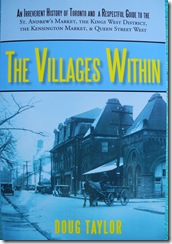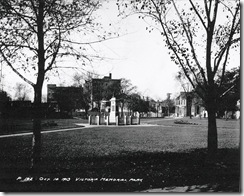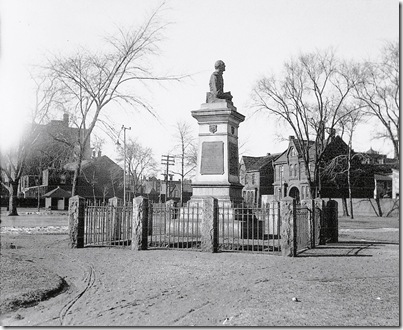Victoria Memorial Square in the King/Spadina area is a hidden jewel among downtown Toronto’s green spaces. Located south of King Street, between Portland and Bathurst Street, is it an oasis of calm in an area that abounds with popular restaurants and clubs. The following information about the square is from the book “The Villages Within,” nominated for the Toronto heritage Awards in 2011.
Victoria Square (The Garrison Burying Ground)
The small open space known as Victoria Square was larger in the nineteenth century than it is today. The boundaries of the burial ground within the square formed a rectangle, with the corners pointing to the four cardinal points of the compass. This was unusual, as it was the custom of the day to align plots parallel to the grid. Almost all streets were also planned according to the gridlines. The reason for the unusual configuration of the cemetery is unknown. At that time, the only other site in the community that was positioned in a similar manner was “Bell Vue,” the home of the Denison Family, located in Denison Square in the present-day Kensington Market area.
When completed in 1794, the cemetery was entirely surrounded by dense forest. The trees were cut down by Simcoe’s troops. Those existing in the square were planted in the twentieth century. In the 1830s, when the land was surveyed and the streets were laid out, the small square was bounded on the north by Stewart Street, the south by Niagara Street, the east by Portland Street, and the west by Bathurst Street. During the years ahead, houses were erected on its western section (on Bathurst Street), reducing the size of the square. Wellington Place ended at the east side of the cemetery. Eventually a street named Douro was cut through the square. This new street as well as Wellington Place were eventually combined and renamed Wellington Street West, as it is today.
Governor Simcoe’s daughter Katherine, who was only fifteen months of age when she died, was the first interment in the cemetery. During the following years many more were buried, including at least one of the soldiers who perished defending York in the American invasion of 1813. During the War of 1812, York was a medical centre where they brought those who had been injured in battles on the Niagara frontier. Reverent John Strachan reported that in 1813 he officiated at the funerals for six to eight men a day.
It is estimated that from the time of its inception in 1794 until the final interment in 1863, about four hundred bodies were placed within the grounds. In the years ahead citizens of the town were also buried here, though after 1807 many were placed in the churchyard of St. James, on King Street East. With the closing of the First Garrison Burying Ground, another cemetery was created to the northwest of Fort York, on Dufferin Street, near the present-day Canadian National Exhibition grounds.
It is worth mentioning a few of those who were buried here in the old Garrison Cemetery, now Victoria Memorial Square. Most of the names that follow were identified by John Ross Robertson during visits to the cemetery in the 1870s. They were recorded in his book Landmarks of Toronto, Volume 1, Mika Publishing, Belleville, 1987.
· Christopher Robinson, father of John Ross Robertson, died 1798.
· Benjamin Hallowell, a relative of Chief Justice Elmsley, died Thursday, March 28, 1799, age 75.
· John Edward Sharps, infant son of J. E. and M Sharps, died at 9 months on August 8, 1813.
· Captain McNeal killed in the Battle of York, 1813, during the American invasion of Toronto.
· Charlotte, wife of John Armitage, died April 8, 1819.
· John Saumariez Colbourne, died May 1, 1826, three-year-old son of Sir John Colbourne.
· Mackay John Scobie, died August 26, 1834, age 18, and his brother Kenneth Scobie, age 25, died in 1834. Their father was Captain John Scobie of the 93rd Highlanders.
· Margaret Ryan, wife of William Ryan of the Canadian Rifles, died 1835.
· Lieutenant Zachariah Mudge, private secretary to Sir John Colbourne (Lord Seaton), committed suicide by placing a gun to his chest. He died at age 31 on June 10, 1831.
· Barbara Mary, daughter of Reverend J. Hudson, died July 17, 1831.
· Archibald Currie of Glasgow, Scotland. Robertson states that the stone was too corroded to decipher any other details.
Final burial in the Garrison Cemetery was Private James McQuarrick in 1863.
*
An interesting notation claims that Captain Battersby, a British soldier, when ordered back to Britain following the War of 1812, shot his two horses and buried them in the cemetery, rather than part with them by selling them to someone else. Thankfully, he did not plan a similar fate for the friends he left behind in tiny York.
The ceremony to unveil the memorial was held on July 1, 1902, as a part of the Dominion Day (Canada Day) celebrations. Veterans of the British army and navy placed the monument in the square. It honours the memory of those who lost their lives defending Upper Canada during the War of 1812 (1812–1815). The regiments that served in the conflict and the names of the battlefields are listed on plaques attached to the monument.
In 1906 a sculpture of the torso of a veteran was added to its crown. The balding soldier appears to be glancing upward, a weary expression on his face. He is attired in a military uniform displaying war medals, and in his right hand is his hat. His left arm has no hand, perhaps a casualty of battle. Katherine Hale, in her book Toronto, Romance of a Great City, (Cassell and Company, Toronto, 1956), states, “The soldier has an unusual face—strong, rapt and dedicated.”
The statue was created by Walter Allward, who also cast the figures at the south base of the Boer War Memorial at University Avenue and Queen Street West. In addition, Allward designed the Canadian war memorial on the Douri plain at Vimy Ridge.
The stone base of the monument in Victoria Memorial Square is similar in design to the one at Queenston Heights to commemorate the deeds of Laura Secord, a heroine of the War of 1812.
To purchase “The Villages Within” : http://bookstore.iuniverse.com/Products/SKU-000175211/The-Villages-Within.aspx
The author’s Home Page: https://tayloronhistory.com/


